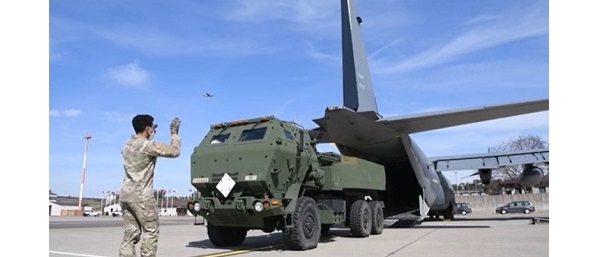
Special Operations Command Europe (SOCEUR) recently conducted a series of exercises that involved the deployment of High Mobility Artillery Rocket System (HIMARS) forward into the battle area. These exercises are known as HIMARS Rapid Aerial Insertion or HIRAIN. The exercises are a demonstration of U.S. European Command’s ability to quickly employ long-range precision fires across Europe. The intent is to show that the U.S. can quickly move the HIMARS to support NATO allies and partners almost anywhere in the theater.
In April 2021 a 352nd Special Operations Wing aircraft and crew left RAF Mildenhall, UK to begin a HIRAIN mission. The aircraft flew to Ramstein, Germany where they on-loaded HIMARS from the 41st Field Artillery Brigade (FAB). The HIMARS vehicles and crew flew on a MC-130J Commando II on a cross-theater Rapid Aerial Insertion operation to Romania. This was the second time in six months that SOCEUR and the 41st FAB has conducted this mission along the Black Sea. Once on the ground in Romania the aircrews and HIMARS crews conducted a rapid off-load and then executed simulated fires within minutes of landing. Upon completion of the fires mission the HIMARS and soldiers were reloaded onto the MC-130J – all in less than an hour. The aircraft returned to Germany, off-loaded the HIMARS, and then returned to home station at RAF Mildenhall.

Photo: HIMARS being loaded onto a MC-130J Commando II at Ramstein Air Base, Germany, April 9, 2021. (Image from video by Master Sgt. Roidan Carlson, 352nd SOW).
The M142 HIMARS system provides a long-range strategic precision fire capability for the U.S. Army and U.S. Marine Corps. HIMARS is a wheeled, all-terrain weather system that can be used in early-entry expeditionary situations. The wheeled artillery system is rapidly deployable via C-130 aircraft. It is mounted on a five-ton vehicle chassis. It is considered a replacement for the M270 Multiple Launch Rocket System (MLRS). The surface-to-surface rocket and missile firing system can range from 15 to 300 kilometers. It can fire the Army Tactical Missile System (ATACMS) missiles and the Guided MLRS rockets. A three-man crew operates the system. Over ground it can travel almost 100 kilometers an hour with a cruising range of about 480 kilometers.
The HIMARS originated as a concept in 1980s – fulfilling a need by the Army for a lightweight Multiple Launch Rocket System. By 1998, prototypes were being tested. The HIMARS capability has been used in both Afghanistan, Iraq, and Syria. The HIMARS is produced by Lockheed Martin.

Photo: A U.S. KC-135 Stratotanker and aircrew from the 100th Air Refueling Wing refueling a MC-130J during the HIMARS Rapid Aerial Insertion mission to Romania. (U.S. Air Force photo by Senior Airman Jennifer Zima, 10 Apr 2021)
Currently there are 17 HIMARS battalions in the U.S. Army. Five in the active component and 12 in the Army National Guard. By 2020 over 500 HIMARS had been produced for use by the U.S. Army. Over 100 HIMARS launchers have been sold to international partner military forces to include Singapore, United Arab Emirates, Jordan, and Romania.
The United States Marine Corps also have the HIMARS (approximately 47). The USMC practices the deployment of HIMARS overland (ground movement), on ships, or by aircraft. During Exercise Noble Fury in October 2020 a HIMARS launcher of the 3rd Battalion, 12th Marine Regiment flew into a recently secured airfield in the Pacific region on an Air Force MC-130J at night. Upon landing, the Marines conducted a simulated long-range, precision firing mission with targeting information received and coordinated while aboard the aircraft in flight. Minutes later, the HIMARs was back on the aircraft and moving to another location for a fire mission.
There are a variety of ways to deliver long-range fires – such as organic attack helicopters and unmanned aerial vehicles (UAVs) as well as air support from the Navy and Air Force. However, many times these assets are constrained by weather conditions and terrain. The HIMARS provides the Army (and SOF) the ability to insert long-range, precision artillery fires in a multi-domain operations (MDO) environment. The US Army is sending two new units to Europe in the fall of 2021 – a Mutlidomain Task Force and a Theater Fires Command. The Pacific region will also have a Multidomain Task Force – the core unit being the 17th Field Artillery Brigade, a unit with two HIMARS battalions.

Photo: HIMARS firing on range in the United States. ASC Army photo, Feb 9, 2021.
The recent HIMARS mission to Romania demonstrated the ability of special operations forces to contribute to the missions of conventional forces in all-domain operations. The joint exercise combined the long-range precision fires of a field artillery brigade with the ability to quickly deploy anywhere in Europe using SOF aircraft.
**********
Photo: Special operations forces from the 352d Special Operations Wing and 41st Field Artillery Brigade executed a High Mobility Artillery Rocket System (HIMARS), Rapid Aerial Insertion (HIRAIN), near Constanta, Romania 10 Apr, 2021. (Courtesy photo by Cristian Dobre).
References:
“NATO ally, Romania, hosts U.S. Joint Forces for Dynamic Force Employment training near the Black Sea”, by Capt. Kevyn Kaler, 352nd SOW, April 10, 2021.
Video, 352nd SOW, April 10, 2021. This 3 mins long ‘B-roll’ depicts the off-load, simulated firing, an on-load of the HIMARS at an airfield in Romania.
U.S. Army Long-Range Precision Fires: Background and Issues for Congress, Congressional Research Service, CRS R46721, March 16, 2021.
https://crsreports.congress.gov/product/pdf/R/R46721